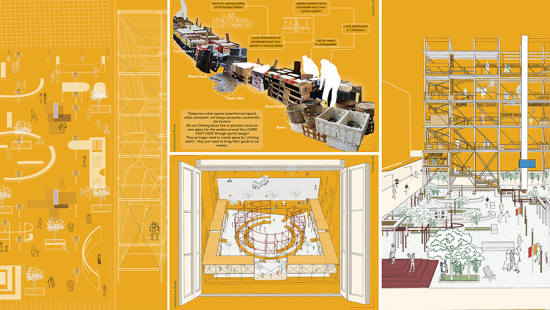Into the Desert: Questions of Coloniality and Toxicity
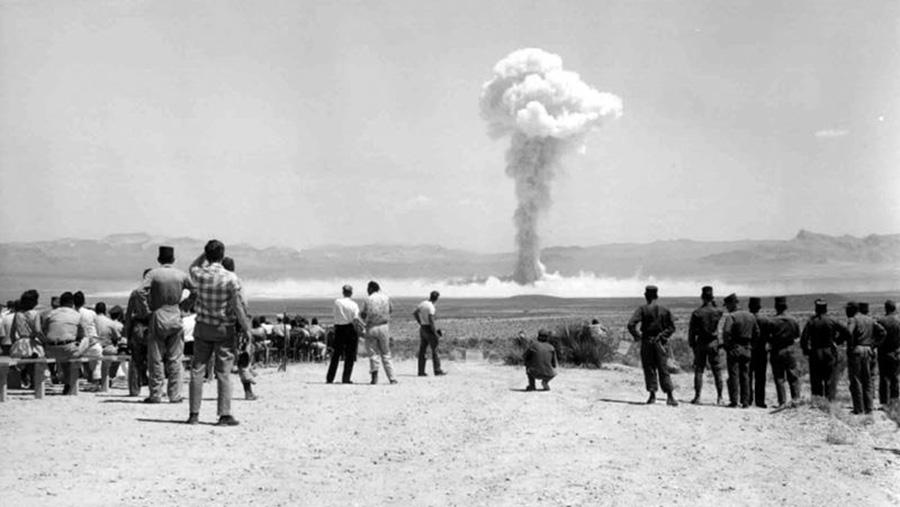
"Small Boy" nuclear test, July 14, 1962, part of Operation Sunbeam, at the Nevada Test Site. photo / © The National Nuclear Security Administration Nevada Site Office Photo Library.
Overview
Deserts are not empty as they have long been seen and represented. Deserts —both hot and cold—have often served to search, extract, and transport various natural resources, such as oil and gas, as well as to design and build new cities, infrastructures, tourist complexes, farming systems, solar power plants, climate, and aerospace research centers, chemical weapons testing complexes, nuclear weapon research centers, and testing sites, and other settlements. How were these designs managed and implemented? What were their impacts on nomadic, semi-nomadic, and sedentary populations and their environments? To what extent did these deserts' transformations influence the politico-economic assets of the governments in question? The Fall 2020 Preston H. Thomas Memorial Symposium will explore the ways in which politicians, scientists, and architects developed, exploited, colonized, transformed, urbanized, militarized, or polluted the underground or overground territories of a number of deserts in the aftermath of the Second World War.
The symposium will feature a series of virtual lectures convened by Assistant Professor of the History of Architecture and Urban Development Samia Henni, who is working on a book project on French nuclear testing sites and military bases in the Sahara Desert. Occurring weekly, scholars, curators, artists, and architects will each approach the topic from a different perspective and discuss one of their current research projects. The aim of the series is to offer a multiplicity of readings of the desert. Each speaker has thirty minutes to introduce the spatial possibilities or limitations of the desert she or he is studying. Taken all together, the lectures stage an intersectional understanding of the spaces and places of the desert. Speakers include:
- Ariella Aïsha Azoulay: Palestine is There, Where it Has Always Been, October 5, 10–11 a.m.
- Dalal Musaed Alsayer: The U.S. Suburb in the Desert: Aramco, Dharhan, Saudi Arabia, c. 1950, October 19, 10–11 a.m.
- Paulo Tavares: Plantation Deserts, October 26, 10–11 a.m.
- Asaiel Al Saeed, Aseel AlYaqoub, Saphiya Abu Al-Maati, and Yousef Awaad: Space Wars: An Investigation into Kuwait's Hinterland, November 5, 3:00–4:30 p.m.
- Nadim Samman: The Antarctic Imaginary, November 6, 3:00–4:30 p.m.
- Menna Agha: Architecture as Governance: Displacement, Resettlement, and Power Tensions in Nubian Resettlement Villages, November 9, 10–11 a.m.
- Alessandra Ponte: Matters of Extraction: The Lithium Triangle (Argentina, Bolivia, Chile), November 16, 10–11 a.m.
- Solveig Suess: Overland, There's Shorter Time to Dream, November 23, 10–11 a.m.
- Zoé Samudzi: Fraught Desert Memorials, November 30, 2020, 10–11 a.m.
The Preston H. Thomas series is funded through a gift to Cornell's College of Architecture, Art, and Planning from Ruth and Leonard B. Thomas of Auburn, New York, in memory of their son, Preston. The symposium lectures are free and open to the public.
Register below for the following lecture dates:
October 5: Ariella Aïsha Azoulay
October 19: Dalal Musaed Alsayer
October 26: Paulo Tavares
November 5: Al Saeed, AlYaqoub, Abu Al-Maati, and Awaad
November 6: Nadim Samman
November 9: Menna Agha
November 16: Alessandra Ponte
November 23: Solveig Suess
November 30: Zoé Samudzi
October 5
 Ariella Aïsha Azoulay: "Salbit. The third soldier from the left puts his hands over his ears to muffle the sound of simultaneous explosions at a number of locations for which these Jewish soldiers and their peers are responsible. This apocalyptic scene of burning villages and earthshaking explosions is also visible to the Palestinian inhabitants of nearby villages. It complements the rumors soldiers whispered to some of their residents after the villages were captured but before the inhabitants were expelled, so that the Palestinians would leave on their own and the claim could be made that they had fled." photo / Palmach Photographic Collection (Album of the Har’el Brigade, Fourth Battalion), probably April 1948
Ariella Aïsha Azoulay: "Salbit. The third soldier from the left puts his hands over his ears to muffle the sound of simultaneous explosions at a number of locations for which these Jewish soldiers and their peers are responsible. This apocalyptic scene of burning villages and earthshaking explosions is also visible to the Palestinian inhabitants of nearby villages. It complements the rumors soldiers whispered to some of their residents after the villages were captured but before the inhabitants were expelled, so that the Palestinians would leave on their own and the claim could be made that they had fled." photo / Palmach Photographic Collection (Album of the Har’el Brigade, Fourth Battalion), probably April 1948
Ariella Aïsha Azoulay: Palestine is There, Where it Has Always Been
10:00–11:00 a.m.
"Architecture makes acceptable the imperial project of world destruction and legitimates the world's (re)construction on empire's terms. Thus, for example, those who destroyed Palestine—a shared world shaped during centuries as well as an echo-system—could describe their project as an achievement, a project of construction—'they made deserts bloom [...] built villages and towns, and created a thriving community [...] bringing the blessings of progress to all the country's inhabitants" (from the "Declaration of Independence,' 1948). Unlearning imperialism consists of a refusal to accept what was achieved through destruction as a fait accompli. Palestine was destroyed in 1948 and since then settler-colonial state apparatuses called Israel to proclaim its disappearance. What does it mean? Through a series of photographs, we will look at the unstoppable imperial movement of (forced) migration of objects and people in different circuits and the destruction of the worlds of which they were part, as well as at the transformation of these worlds into construction sites where everything could be made into raw material."
~Ariella Aïsha Azoulay
Bio:
Ariella Aïsha Azoulay is a Professor of Comparative Literature and Modern Culture and Media at Brown University, as well as a curator and documentary filmmaker. Her recent books include Potential History: Unlearning Imperialism (2019); Civil Imagination: The Political Ontology of Photography (2012); From Palestine to Israel: A Photographic Record of Destruction and State Formation, 1947-1950 (2011); and The Civil Contract of Photography (2008). She is the curator of Errata, Fundació Antoni Tàpies, 2019; Act of State 1967-2007, Centre Pompidou, 2016; Enough! The Natural Violence of the New World Order, F/Stop festival, Leipzig, 2016; and The Natural History of Rape, Pembroke Hall, Brown University, 2016.
Register here for the lecture.
October 19
 Will Martin (2019), "From an Unexplored Desert to a near $2 Trillion IPO: The 86-Year History of Saudi Aramco in Pictures." Selected and captioned by Dala Musaed Alsayer. photo / Business Insider, © Getty Images
Will Martin (2019), "From an Unexplored Desert to a near $2 Trillion IPO: The 86-Year History of Saudi Aramco in Pictures." Selected and captioned by Dala Musaed Alsayer. photo / Business Insider, © Getty Images
Dalal Musaed Alsayer: The U.S. Suburb in the Desert: Aramco, Dharhan, Saudi Arabia, c. 1950
10:00–11:00 a.m.
"In 1933, the Standard Oil of California (SoCal) was granted an exploratory concession for Saudi Arabia’s Eastern Provinces and three years later, they discovered one of the world’s largest oil fields. In encountering the desert, SoCal’s employees did not attempt to understand it but instead projected onto it an environmental imaginary, envisioned how it came about, and immediately wanted to overcome, tame, and order it. While the first inhabitants were mainly single men who were originally housed in barracks-style dormitories, they were soon joined by their wives and children, and prefabricated homes were imported to house them. A fence was erected around their homes and by 1945, Dhahran began to look like its U.S. suburban counterpart, with a neat cul-de-sac and lawn-lined streets with a complex network of people, animals, and infrastructure to support it. Anywhere, U.S.A. was born and the Arabian American Company (Aramco) was established. The company devised a housing strategy that segregated the population along marital and racial lines. While U.S. families lived in the fenced suburb, Saudi men were kept outside living in makeshifts houses, Italians construction workers lived in a barrack-style compound, and non-Saudi Arabs and South East laborers lived in separate dormitories. By 1943, this spatial, racial, and ethic segregation resulted in riots from those excluded from living inside the fenced suburb. To address this, Aramco devised the Home Ownership Program (HOP) to house its Saudi employees outside of the Dhahran district in newly designed suburban tracts. Through a close reading of the architecture built, the story of Aramco’s Dhahran reveals the environmental and urban ramifications of the world’s largest petrochemical conglomerate and the suburb that restructured society and urbanism. Embodied as Anywhere, U.S.A., company towns such as Aramco created an architecture and urbanism that was all at once everywhere, anywhere, and nowhere."
~Dalal Musaed Alsayer
Bio:
Dalal Musaed Alsayer is an Assistant Professor of Architecture at Kuwait University. Her research lies at the intersection of architecture, environment, and development in the context of the Middle East and North Africa during the twentieth century. She is the coauthor of Pan-Arab Modernism: History of Architectural Practice in The Middle East (Actar, 2021). She is currently developing her manuscript based on her dissertation, Architecture, Environment, Development: The United States and the Making of Modern Arabia, 1949-1961 which examines the ways U.S. development programs sought to transform the social, environmental, and urban fabric of the Arab World. She holds a Bachelor of Architecture from Kuwait University; a Master of Science in Architecture and Urban Design from the GSAPP, Columbia University; a Master of Design Studies in Urbanism, Landscape, Ecology, from GSD, Harvard University; and a Master of Science and Ph.D. in Architecture from the University of Pennsylvania.
Register here for the lecture.
October 26
 Soy seeds at a bio-tech laboratory in Lucas do Rio Verde, Brazilian Amazon (2015). Selected and captioned by Paulo Tavares. photo / © Armin Linke
Soy seeds at a bio-tech laboratory in Lucas do Rio Verde, Brazilian Amazon (2015). Selected and captioned by Paulo Tavares. photo / © Armin Linke
Paulo Tavares: Plantation Deserts
10:00–11:00 a.m.
"During the colonial period, the Portuguese referred to Brazil's vast hinterlands as the sertão, a word whose etymology points to desertão, meaning a territory that is a deserted, empty, wild, depopulated. Rather than fixing a specific geography or denoting an arid environmental condition, sertão described a political space in opposition to the areas controlled by colonial power, which were mainly situated on the coast. In other words, sertão demarcated the frontiers of Empire, and hence the concept could be applied to describe hinterland territories as ecologically diverse as the desert-like regions of northeast Brazil and the humid forests of the Amazon.
This colonial geography that saw the Amerindian territories of the Brazilian interior as a deserted, voided territory in need of occupation and colonization has been formative to the modern process of nation-building in Brazil, defining a state ideology that aligns national progress with a historic process of 'auto-imperialism.' From the 'ex-nihilo' construction of the modernist capital Brasília to the modernizing plans of the military regime, this ideology led to a set of policies promoting frontier occupation with development projects focused on large-scale agribusiness, chiefly for soy exports. This in turn caused disastrous effects to indigenous communities and the Amazon ecology, converting vast areas of primary forests into an endless landscape of mono-crop plantations.
Plantations, as Anna Tsing writes, are 'machines of replication' devoted to ecological simplification and the production of sameness. Sustained by massive petrochemical inputs, contemporary plantation’s deserted and sterile landscapes are not only lifeless, harboring very low biodiversity, they are also lethally toxic for various non-human beings, destroying their habitats and therefore leading to species extinction. It is in these areas of the Amazon, where massive deforestation has significantly altered the environment, that the impacts of global warming are being most severely felt, with identifiable evidence of a potential 'desertification' of the rainforest, somehow accomplishing the environmentally destructive dimension of old imagined colonial geographies. Indeed, as this talk argues, the historic-political origins of the post-climate change scorched lands of planet Earth are to be found in the violent world-destroying processes captained by imperialism."
~Paulo Tavares
Bio:
Paulo Tavares is an architect, researcher and writer based in South America. He is the author of the books Forest Law (2014), Memória da Terra (2020), and Des-Habitat (2019). Tavares's design and pedagogic practice spans different territories, social geographies, and media. He taught design and visual cultures at the Facultad de Arquitectura, Diseño y Artes de la Pontifícia Universidad Católica del Ecuador in Quito, and prior to that led the M.A. program at the Centre for Research Architecture at Goldsmiths in London. He is currently professor at the Faculdade de Arquitetura e Urbanismo at the University of Brasília, Brasil. In 2017 Paulo Tavares created the agency autonoma, a platform dedicated to urban research and intervention. Tavares is a long-term collaborator of Forensic Architecture and was a fellow at the Canadian Centre for Architecture (2018-2019). He co-curated the Chicago Architecture Biennial 2019.
Register here for the lecture.
November 5
 Selected by Asaiel Al Saeed, Aseel AlYaqoub, Saphiya Abu Al-Maati, and Yousef Awaad. photo / © Space Wars – KPVB2021
Selected by Asaiel Al Saeed, Aseel AlYaqoub, Saphiya Abu Al-Maati, and Yousef Awaad. photo / © Space Wars – KPVB2021
Asaiel Al Saeed, Aseel AlYaqoub, Saphiya Abu Al-Maati, and Yousef Awaad: Space Wars: An Investigation into Kuwait's Hinterland
3:00–4:30 p.m.
"Commissioned by the National Council for Culture, Art and Letters (NCCAL), the Kuwait Pavilion at the 17th International Architecture Exhibition of la Biennale di Venezia attempts to respond to the theme set forth, 'How will we live together?' through the discovery, interpretation, and projection of the hinterland. The curators–working across the boundaries of architecture, art, policy, and urbanism–were selected in response to NCCAL's interest in commissioning projects that engage with cultural expressions and archaeological histories embodied in the desert landscape.
Kuwait's regional positioning has generated historical references through which these landscapes can be read, with the year 2021 marking the 70th anniversary of the First Master Plan commission and the 30th anniversary of the Gulf War (also known as 'The First Space War'). This year's approach positions Kuwait as a case study to understand past, present, and future narratives while offering itself as a testbed to explore hinter-urban spaces that enable the state.
Often viewed as a counter to the forms that constitute the metropolitan, the surrounding and seemingly unoccupied landscapes serve as the nation's functional staging ground through resource extraction, agricultural cultivation, military installations, and cultural sedimentation. As the radial city's imminent growth looms, the status of these spaces remains up in the air. Their competing functions, ambiguous growth patterns, and land management processes will inevitably lead to spatial 'wars' that compete for survival. How will these spaces continue to exist next to, between and amidst one another?
Space Wars seeks to address these questions through an in-depth inquiry and analysis of the hinterland, projecting spatial defenses, offenses or alliances that define the future of these landscapes under threat—threat from extinction, threat from overuse, threat from domination and, at times, the threat of being forgotten."
~Asaiel Al Saeed, Aseel AlYaqoub, Saphiya Abu Al-Maati, and Yousef Awaad
Bios:
Asaiel Al Saeed is an architect who obtained her professional Bachelor of Architecture from Kuwait University. She is currently practicing while co-teaching the architecture undergraduate thesis studio at Kuwait University. Her research interest lies within the process of planning around contested sites, resources, living heritage, and the policy-making that forms conflicted spatial conditions. With a focus on the development and regression of agricultural practices specific to Kuwait, she has been studying and projecting into the changing urban form of the city of Jahra in relation to its agricultural heritage and modern history.
Aseel AlYaqoub is a research-based and multi-disciplinary artist working across the disciplines of history, political theory, and architecture. Her practice speaks to the inherited methodologies that define nationhood, state apparatuses, and the counterfeits they produce. She holds a Bachelor of Arts from Chelsea College of Art and Design, London, and a master’s in fine arts from Pratt Institute, New York. AlYaqoub was awarded the Architzer A+Award in collaboration with Studio Toggle (2020) and the Art Jameel Commission in collaboration with Alia Farid (2018). Her work has been exhibited at the Museum of Humour and Satire (Gabrovo), Edge of Arabia (London), Pierogi Gallery (New York), The Design Terminal (Budapest), Sultan Gallery (Kuwait), Museum of Modern Art (Kuwait) and The Contemporary Art Platform (Kuwait). Her research has been presented at symposiums such as Abu Dhabi Art (Abu Dhabi), Nuqat Conference (Kuwait) and The National Museum (Doha).
Saphiya Abu Al-Maati holds a master’s in architecture from Columbia University and a Bachelor's of Peace Conflict Studies/Human Security from UC Berkeley. Saphiya's research on the influence of regional political parties on the development of Kuwait has been presented at the UNESCO World Heritage Conference (Bahrain), as well as the International Association for the Study of Traditional Environments Conference (Portugal). She has been awarded the Science Po + KFAS Travel Grant for the study of 'Diplomacy, Anthropology, Climate, and Conflict' and has co-taught studio courses at Barnard College and Columbia University GSAPP. Most recently, she has worked as an Advisor to the Hareer and Boubyan Development Agency, in addition to the Kuwait Council of Ministers, consulting on upcoming national urban projects.
Yousef Awaad is an Architect researching systematic processes and tools embedded in forms of inhabited territories. He holds a master's in architecture from Harvard University, Graduate School of Design and a Bachelor of Science in Architecture with distinction from McGill University. He is the recipient of Harvard University's Penny White Project Fund for a proposal titled Kuwaits Urban Landscape: An Aerial View, and the Center for Geographic Analysis' Fisher Prize for a study titled Territory, Survey, Cartography - South China Sea. His research has been published and presented at a number of symposiums including the ISOCARP World Planning Congress, and the International Association for the Study of Traditional Environments. Yousef is currently the Project Manager for the 4th Kuwait Master Plan and holds a position as Senior Urban Designer at Perkins and Will, working on projects across London, Makkah, Dublin, and New York.
Register here for the lecture.
November 6
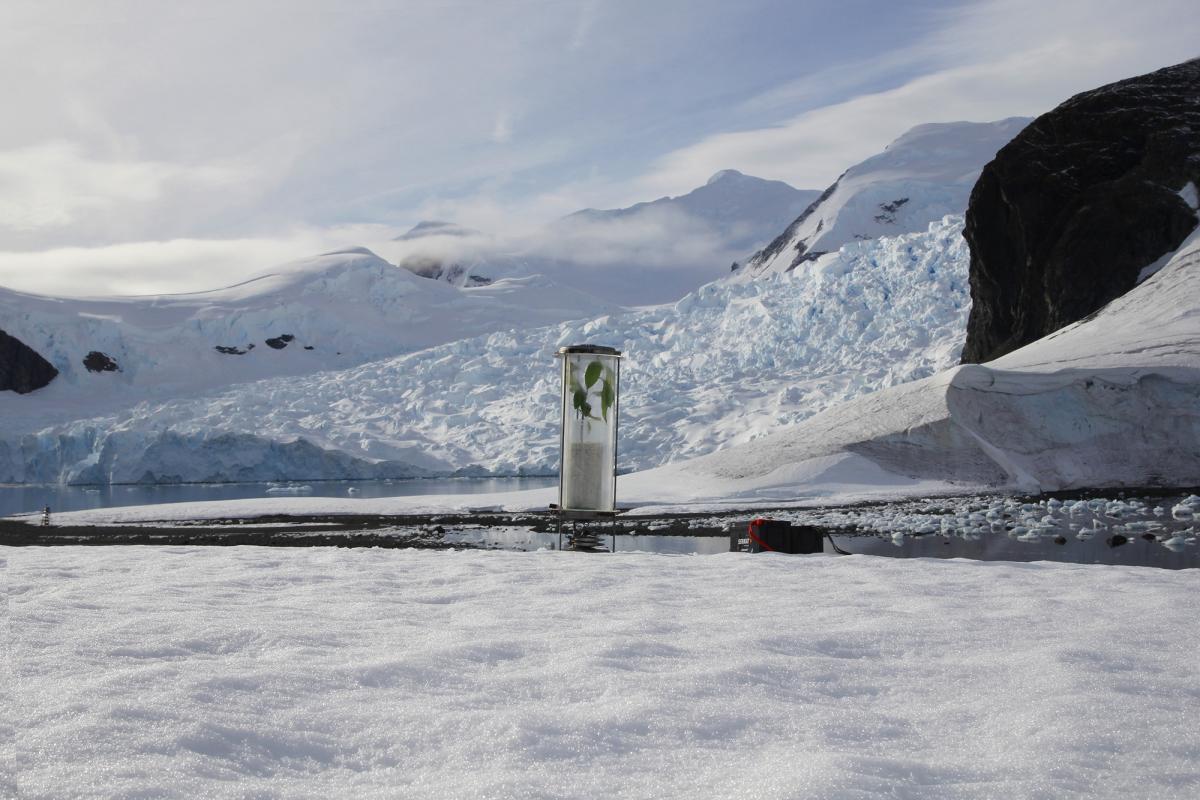 "Arriba!" by Paul Rosero Contreras, 2017. Selected and captioned by Nadim Samman. photo / © PRC and www.narodizkiy.com
"Arriba!" by Paul Rosero Contreras, 2017. Selected and captioned by Nadim Samman. photo / © PRC and www.narodizkiy.com
Nadim Samman: The Antarctic Imaginary
3:00–4:30 p.m.
"According to the 1959 Antarctic Treaty, the world's southern continent is reserved for peaceful scientific enterprise. Owned by no individual or nation (with sovereign claims suspended), its legal-institutional framework is the most successful example of international cooperation in the previous century. The exclusive right that this document accords research, incorporating a proscription against the exploitation of natural resources, and conflict, is justly celebrated. But is this the whole story? The Antarctic Pavilion and Antarctic Biennale projects (2015 to present) explored Antarctica’s repressed cultural dimension—asking what role the Antarctic Imaginary can play in the constitution of new political subjectivities. Can we be Antarctican? What role do art and architecture have?"
~Nadim Samman
Bio:
Nadim Samman read Philosophy at University College London before receiving his Ph.D. from the Courtauld Institute of Art. He was co-director of Import Projects e.V. in Berlin from 2012 to 2019 and, concurrently, curator at Thyssen-Bornemisza Art Contemporary, Vienna (2013-2015). He curated the 4th Marrakech Biennale (with Carson Chan) in 2012, and the 5th Moscow Biennale for Young Art in 2015. He co-founded and co-curated the 1st Antarctic Biennale (2017) and the Antarctic Pavilion (Venice, 2015-). In 2014 Foreign Policy Magazine named him among the '100 Leading Global Thinkers.' Widely published, in 2019 he was first prize recipient of the International Award for Art Criticism (IAAC). He is currently a curator at KW Institute for Contemporary Art, Berlin.
Register here for the lecture.
November 9
 Selected by Menna Agha. photo / © Menna Agha
Selected by Menna Agha. photo / © Menna Agha
Menna Agha: Architecture as Governance: Displacement, Resettlement, and Power Tensions in Nubian Resettlement Villages
10:00–11:00 a.m.
"In 1964, the Egyptian government displaced Nubians from their homeland to state-built settlements all to clear the way for the Aswan High Dam. After their involuntary resettlement, Nubians and their indigenous institutions have suffered cultural and economic disenfranchisement. I will present you a case in my home village, Qustul. I will walk you through our village and inspect the role of a modernist built environment in the disenfranchisement of Nubians, to examine how the agency works on a day to day basis. From a national enterprise, to a religious fundamentalist operation, to an indigenous institution struggling to sustain itself, the powers at play in Qustul shift perpetually unsettling the settlement. I ask questions about the reasons for spatial injustice, stigma, and discomfort in my home village and look at the stories of myself, my kin, and buildings. My questions require my visceral implication in the answer and consequently open my eyes to modes of spatial resistance and resurgence in an unsettled settlement."
~Menna Agha
Bio:
Menna Agha is a visiting assistant professor at the University of Oregon. She is a researcher and architect who earned a Ph.D. in architecture from the University of Antwerp and a MA in integrated design, with a focus on gender and design, from the Technical University of Cologne, Germany. Spatial justice is an overarching theme in Agha's work, however, she explained, this is not a choice born of luxury. She is a third-generation Nubian woman displaced by the Egyptian state as part of the Aswan High Dam project in the 1960s.
Register here for the lecture.
November 16
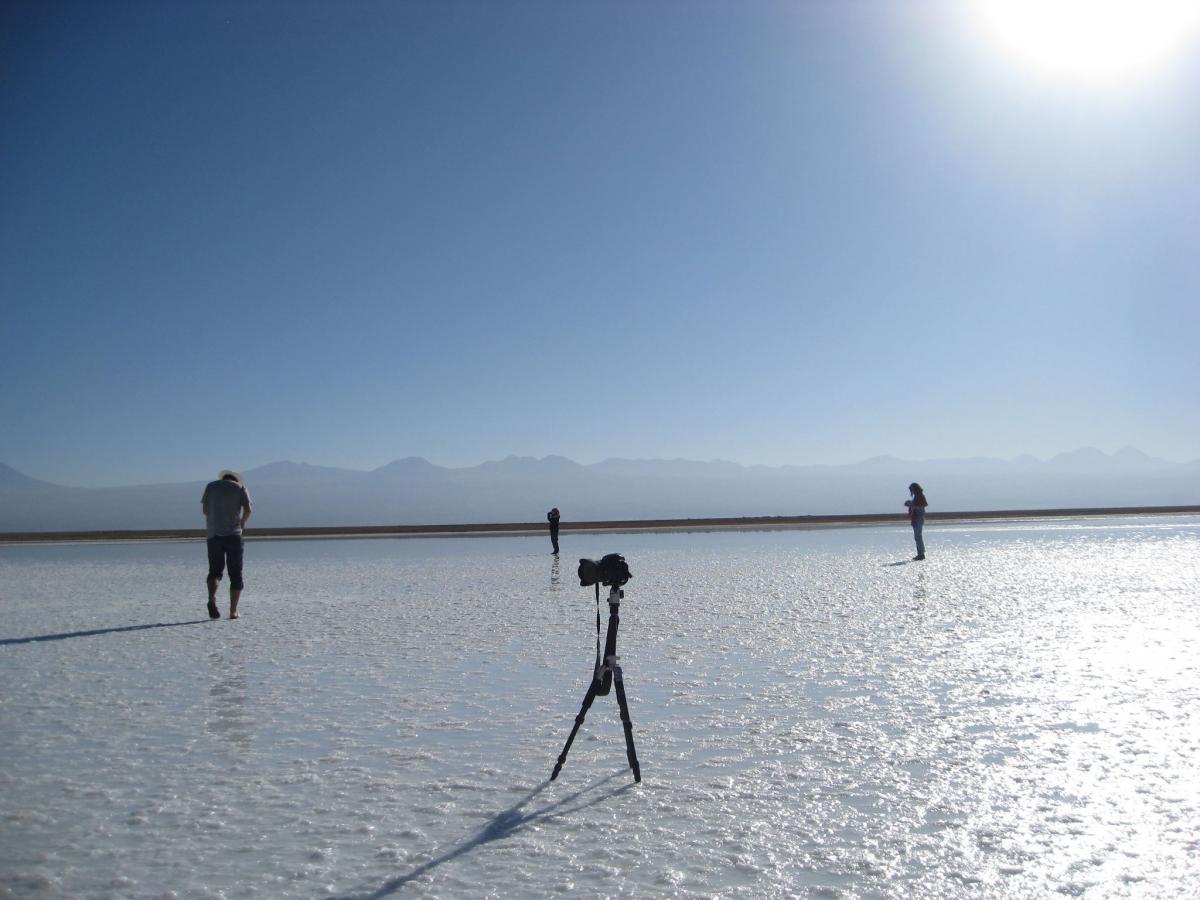 Atacama Desert, Chile. Selected and captioned by Alessandra Ponte. photo / © Alessandra Ponte
Atacama Desert, Chile. Selected and captioned by Alessandra Ponte. photo / © Alessandra Ponte
Alessandra Ponte: Matters of Extraction: The Lithium Triangle (Argentina, Bolivia, Chile)
10:00–11:00 a.m.
"According to recent surveys, 85 percent of the world reserve of lithium found in salt flats, from which extraction is easiest, is located at high altitude in the Andes, in the so-called "lithium triangle" comprising the salt flats of Salar de Atacama in Chile; Salar de Uyuni in Bolivia; and Salar del Hombre Muerto in Argentina. Lithium, a basic chemical element, is now a strategic resource employed in the production of the batteries necessary to power our phones, laptops, tablets, and, following the new 'green' paradigm of electromobility, more and more electric cars, scooters, bikes, and automated vehicles. Thus, in the last decade Chile, Argentina, and Bolivia have become a privileged target of the international mining industry determined to exploit their deposits of lithium for maximum profit and minimum cost. Controlled by dissimilar legal frameworks and public policies for the management of mineral extraction, indigenous people's rights, and environmental protection, the three countries are reassessing a historical predicament: lithium can drive one more export explosion or serve as a catalyst to new forms of responsible development. '…thinking takes place in the relationship of territory and earth,' remind us Gilles Deleuze and Félix Guattari's What Is Philosophy? (1992). The paper is an attempt to begin to think as designers about matters that connect the geological and local to change at a planetary scale."
~Alessandra Ponte
Bio:
Alessandra Ponte is a professor at the École d’architecture at the Université de Montreal. She has also taught at Princeton University, Cornell University, Pratt Institute, the ETH Zurich, and at the Istituto Universitario di Architettura di Venezia. Since 2008 she has been responsible for the Phyllis Lambert International Seminar, annual events addressing current topics in landscape and architecture. She curated the exhibition Total Environment: Montreal 1965–1975 at the CCA and collaborated on the exhibition and catalog God & Co: François Dallegret Beyond the Bubble at the GTA. She has published a collection of essays on North American landscapes entitled The House of Light and Entropy (2014). She collaborated on Extraction and Future North exhibitions curated for the Canadian Pavilion at the Venice Biennale in 2014 and 2016. Since 2017 she has conducted research by design studios with the master students of the UdeM on "Architecture and Information 2.0" and published the results of the investigations in three volumes (2017, 2018, 2019).
Register here for the lecture.
November 23
 Selected by Solveig Suess. image / © Solveig Suess, AAA Cargo, 2018, video still
Selected by Solveig Suess. image / © Solveig Suess, AAA Cargo, 2018, video still
Solveig Suess: Overland, There's Shorter Time to Dream
10:00–11:00 a.m.
"The low pressures in the atmosphere over the Taklamakan and Gobi deserts create windy conditions in the area during late winter and early spring. Loose top soils are picked up by westerly winds, pulling these sands into an increasingly intense Asian dust storm. Freezing all activity in its path, these storms have become an annual occurrence in western China, compared to half a century ago when each phenomenon struck only once every seven or eight years. Their movements have become an increasing threat to the bourgeoning infrastructural projects of the Belt and Road Initiative which stretch across their paths. In this talk and discussion, we begin from inside the dust storm. It is here where we learn how geographies that have long appeared in the peripheries of popular imagination, have been central in the formation of supply chain capitalism—contingent upon state support, concentration and monopolization of capital power, and the organization of weather and the environment itself. Such 'random acts of violence' brought by these storms call for an urgent need to shift our common-sense understandings and contemporary culture in ways which are both imaginary and epistemological. While the Belt and Road imaginary evokes a liquid and mobile world of commodity exchange, its political infrastructures are generating closures as much as openings, stasis as much as flow. These new geometries mark not only the geopolitical reorganization of goods, people, capital, and ideas, but also forms of resistance expressed through movements, grain by grain. The symposium will draw on Solveig’s documentary-led research into the New Silk Road, mapping these constellations through interviews, field recordings, found WeChat videos with excerpts from her documentary AAA Cargo (2018)."
~Solveig Suess
Bio:
Solveig Suess’s work focuses on embodied and ecological politics across infrastructural environments, through documentary-making, research, and writing. Her practice engages with how circuits of trade, information, and climates are inextricably tied to the politics of capital, power, and control. Her inaugural film AAA Cargo is a documentary-essay on the New Silk Road, where government efforts to speed up trade collide with more-than-human choreographies of materials. Solveig collaborates with Asia Bazdyrieva on Geocinema, through which they research how environmental sensing has articulated Earth transformations, using expanded cinema as a method to investigate aesthetics in geopolitical systems. Solveig was a former Digital Earth fellow, holds a Masters from the Centre of Research Architecture, Goldsmiths, and is currently a Ph.D. researcher with the Cycles of Circulation project at Critical Media Lab Basel. Her work has been exhibited worldwide including Rotterdam International Film Festival, Images Festival Toronto, ArtScience Museum Singapore, ZKM Karlsruhe, OCAT Beijing, Konsthall Trondheim. In 2020 Geocinema was nominated for the Schering Stiftung Award for Artistic Research.
Register here for the lecture.
November 30
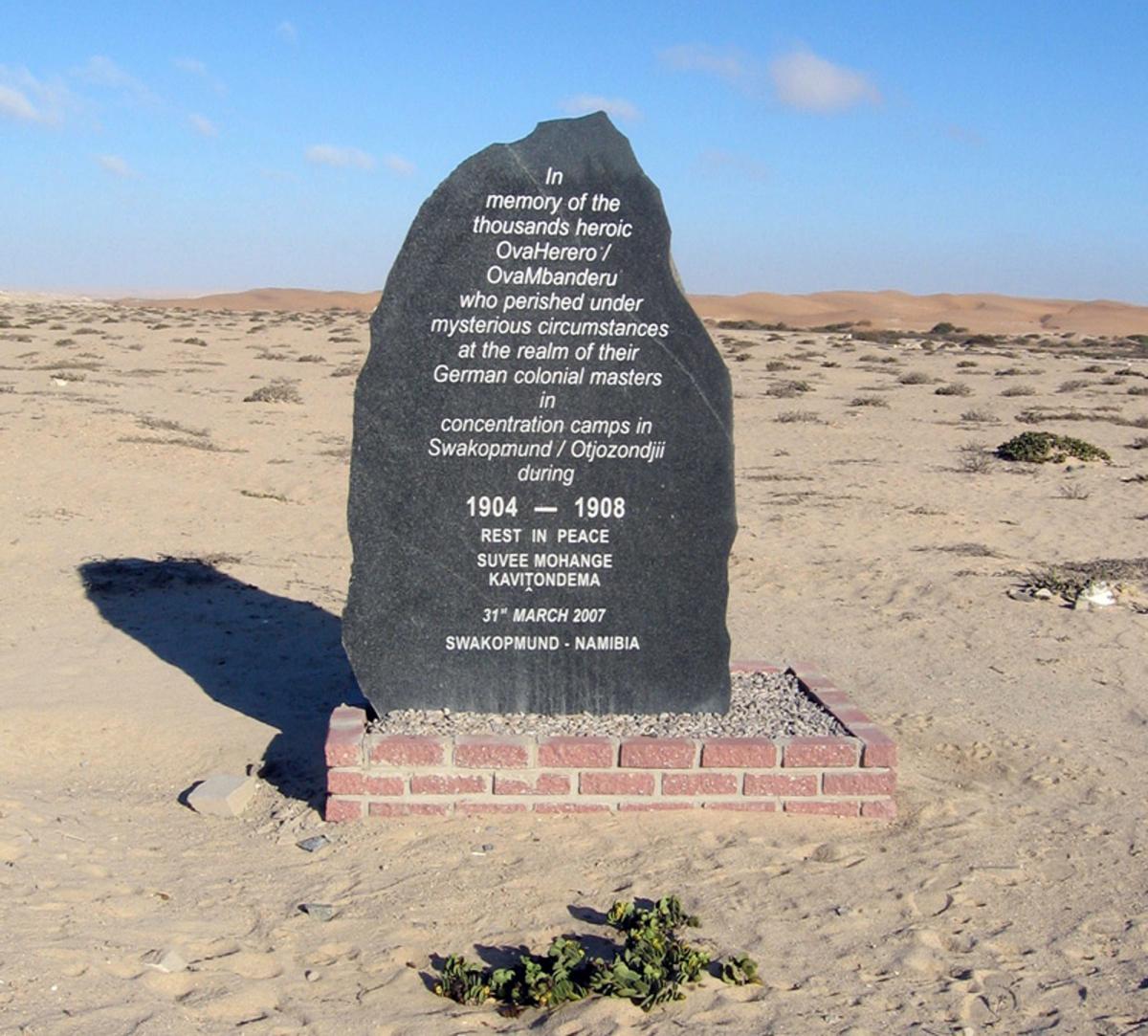 A genocide memorial erected in 2007 in the Swakopmund cemetery. Selected and captioned by Zoé Samudzi. photo / © Elke Zuern
A genocide memorial erected in 2007 in the Swakopmund cemetery. Selected and captioned by Zoé Samudzi. photo / © Elke Zuern
Zoé Samudzi: Fraught Desert Memorials
10:00–11:00 a.m.
"Namibia, the driest country in Sub-Saharan Africa, is framed by deserts: the red sand Kalahari Desert in the interior, and the coastal Namib Desert whose picturesque dunes meet the Atlantic Ocean. During the German imperial settlement, the former desert was a critical part of the genocidal military theater. Following the 1904-08 Herero Wars, the inhospitable terrains of the southern coast near Lüderitz were home to the Shark Island (otherwise known as 'Death Island') concentration camp and four others. Within the country’s history is the weaponization of deserts, and a geography carved up by colonial social Darwinist ideas of race, followed by apartheid divisions and then attempted unification after independence. The land, demarcated by historical settler claims and past-present indigenous homelands, is a site of contested memory with all Namibians —beneficiaries and victims of colonialism (and the genocide) alike —able to stake claims to space and belonging. It is against this socio-historical backdrop that white Namibian artist Max Siedentopf created the work Toto Forever (2019), a solar-powered sound installation in an unidentified location in the Namib Desert that will play Toto’s memetic 1982 song, Africa, in perpetuity. The song is described by its songwriter and Toto’s drummer Jeff Porcaro as 'a white boy is trying to write a song on Africa' using only 'what he's seen on TV or remembers in the past'; what is the border between artistic humor and trivialization?"
~Zoé Samudzi
Bio:
Zoé Samudzi is a writer and a doctoral candidate in Medical Sociology at the University of California, San Francisco. Her work focuses on German colonialism, the Herero and Nama genocide, its scientific afterlife, and the production of indigenous Black/African identity. Along with William C. Anderson, she is the coauthor of As Black as Resistance: Finding the Conditions for Our Liberation (AK Press, 2018). She is currently a fellow with Political Research Associates.
Register here for the lecture.





